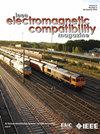A Simple Mathematical Expression for Nonlinear Resistive Characteristics of Metal Oxide Elements in Lightning Surge Analysis
IF 2.5
3区 计算机科学
Q3 ENGINEERING, ELECTRICAL & ELECTRONIC
IEEE Transactions on Electromagnetic Compatibility
Pub Date : 2025-04-17
DOI:10.1109/TEMC.2025.3557863
引用次数: 0
Abstract
Accurate simulations of transient phenomena in electric power systems with metal oxide varistors (MOVs) or lightning arresters (LAs) using the finite-difference time-domain (FDTD) method for solving Maxwell's equations require simple and accurate representations of MOVs or LAs. By representing a small cell within a MOV or LA with resistivity (雷电浪涌分析中金属氧化物非线性电阻特性的简单数学表达式
利用有限差分时域(FDTD)方法求解麦克斯韦方程组,精确模拟具有金属氧化物压敏电阻或避雷器的电力系统中的瞬态现象,需要简单而准确地表示金属氧化物压敏电阻或避雷器。通过用电阻率(ρ)依赖于电场(E)来表示MOV或LA内的小单元,这些组件可以在三维中建模并无缝集成到FDTD仿真中。为了提高时域有限差分仿真的计算效率,必须避免对ρ e进行迭代计算。因此,迫切需要一个简单而准确的ρ e数学表达式。本文提出了一种从实验数据推导三系数指数函数的方法。该方法利用积分特性,将非线性特征转化为线性特征,无需迭代处理和均匀采样。它还结合了数据加权和离群值判别,以提高准确性。利用上升时间约为8 μs的外加电流,通过与以往基于普通最小二乘法的方法和实验数据的对比分析,证实了该方法计算脉冲电流注入残余电压的精度和有效性。
本文章由计算机程序翻译,如有差异,请以英文原文为准。
求助全文
约1分钟内获得全文
求助全文
来源期刊
CiteScore
4.80
自引率
19.00%
发文量
235
审稿时长
2.3 months
期刊介绍:
IEEE Transactions on Electromagnetic Compatibility publishes original and significant contributions related to all disciplines of electromagnetic compatibility (EMC) and relevant methods to predict, assess and prevent electromagnetic interference (EMI) and increase device/product immunity. The scope of the publication includes, but is not limited to Electromagnetic Environments; Interference Control; EMC and EMI Modeling; High Power Electromagnetics; EMC Standards, Methods of EMC Measurements; Computational Electromagnetics and Signal and Power Integrity, as applied or directly related to Electromagnetic Compatibility problems; Transmission Lines; Electrostatic Discharge and Lightning Effects; EMC in Wireless and Optical Technologies; EMC in Printed Circuit Board and System Design.

 求助内容:
求助内容: 应助结果提醒方式:
应助结果提醒方式:


